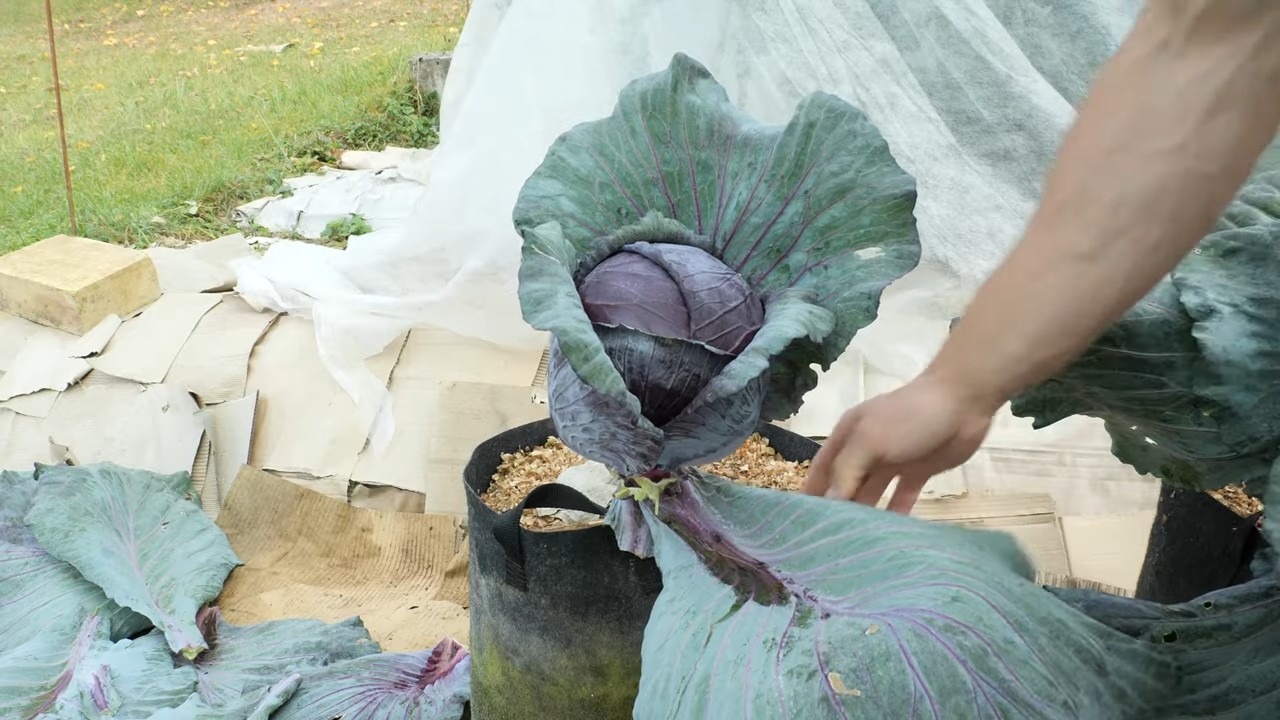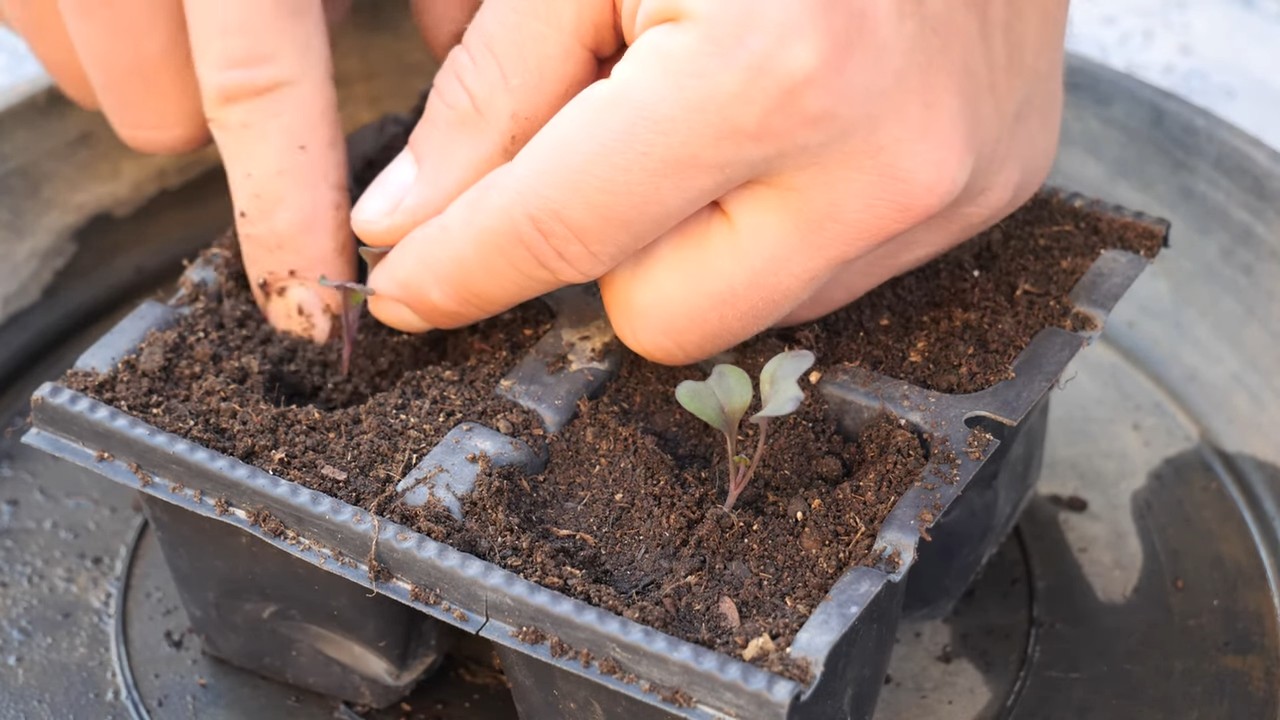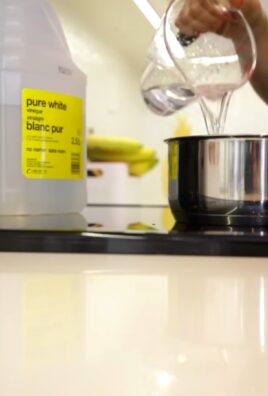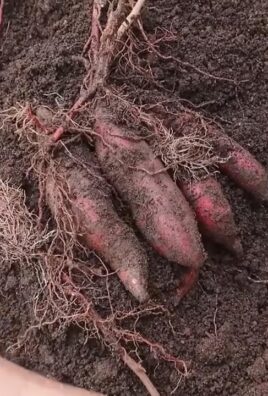Balcony Red Cabbage Gardening: Ever dreamed of harvesting vibrant, jewel-toned red cabbages right outside your kitchen door, even if you only have a small balcony? I know I have! Forget sprawling acres; urban gardening is booming, and you can absolutely cultivate these beauties in containers. This DIY guide will unlock the secrets to successful balcony red cabbage gardening, transforming your limited space into a mini-farm bursting with color and flavor.
Growing your own food, especially something as visually stunning as red cabbage, is incredibly rewarding. While the history of cabbage cultivation stretches back thousands of years, with evidence suggesting its presence in ancient Rome and Greece, the joy of nurturing a plant from seed to harvest is a timeless tradition. Think of it as a modern take on the victory garden, bringing self-sufficiency and a touch of nature to your urban life.
But why red cabbage? Beyond its striking appearance, red cabbage is packed with nutrients and antioxidants, making it a superfood you can easily access. Plus, let’s be honest, store-bought red cabbage can sometimes be lackluster. This DIY guide will show you how to grow cabbages that are fresher, tastier, and more vibrant than anything you’ll find at the grocery store. I’ll walk you through everything from choosing the right container and soil to protecting your precious plants from pests, ensuring you have a bountiful harvest of balcony red cabbage gardening success. So, grab your gardening gloves, and let’s get started!

Balcony Red Cabbage Gardening: A Colorful and Compact Guide
Hey there, fellow balcony gardeners! Ready to add a splash of vibrant color and delicious crunch to your small space? We’re diving into the wonderful world of growing red cabbage right on your balcony. Trust me, it’s easier than you think, and the results are incredibly rewarding. I’ll walk you through everything you need to know, from choosing the right container to harvesting your beautiful, homegrown red cabbage.
Choosing the Right Variety and Container
Before we get our hands dirty, let’s talk about variety and container selection. Not all red cabbages are created equal, and the right container can make all the difference in your success.
* Variety Selection: Look for compact or dwarf varieties specifically bred for smaller spaces. Some excellent choices include ‘Red Express,’ ‘Ruby Ball,’ and ‘Red Acre.’ These varieties tend to mature faster and stay smaller, making them perfect for balcony gardening. I personally love ‘Red Express’ because it’s super quick to mature!
* Container Size: Red cabbages need room to grow, so opt for a container that’s at least 12 inches in diameter and 12 inches deep. A larger container (15-18 inches) is even better, especially if you plan on growing multiple cabbages in the same pot.
* Container Material: Plastic, terracotta, or even fabric grow bags will work. Just make sure your container has adequate drainage holes. I’ve had great success with both plastic pots and fabric grow bags. Fabric pots offer better aeration for the roots, which can be a real advantage.
* Drainage is Key: Seriously, don’t skip this! Cabbages hate sitting in soggy soil. Make sure your container has plenty of drainage holes to allow excess water to escape. You can even add a layer of gravel or broken pottery at the bottom of the container to improve drainage.
Preparing the Soil and Planting
Now for the fun part – getting our hands dirty! Proper soil preparation is crucial for healthy cabbage growth.
* Choosing the Right Soil: Red cabbages thrive in well-draining, fertile soil that’s rich in organic matter. A good quality potting mix specifically formulated for vegetables is your best bet. Avoid using garden soil, as it can be too heavy and compacted for container gardening.
* Amending the Soil: To give your cabbages an extra boost, amend your potting mix with compost or well-rotted manure. This will provide essential nutrients and improve soil drainage. I usually add about 25% compost to my potting mix.
* Starting from Seed vs. Transplants: You can start red cabbage from seed indoors 6-8 weeks before the last expected frost, or you can purchase transplants from a local nursery. Transplants are a great option if you’re short on time or don’t have a good setup for starting seeds indoors. I often use transplants because it’s just easier!
* Planting Transplants: When planting transplants, dig a hole that’s slightly larger than the root ball. Gently remove the transplant from its container and loosen the roots slightly. Place the transplant in the hole, ensuring that the top of the root ball is level with the soil surface. Backfill the hole with soil and gently firm it down.
* Planting Seeds: If starting from seed, sow seeds about 1/4 inch deep and 1 inch apart. Once the seedlings emerge, thin them to one plant per container or space them at least 12 inches apart if planting multiple cabbages in a larger container.
* Watering After Planting: Water thoroughly after planting to help settle the soil and establish good contact between the roots and the soil.
Caring for Your Red Cabbage
Consistent care is essential for growing healthy and productive red cabbages on your balcony.
* Watering: Red cabbages need consistent moisture, especially during hot weather. Water deeply whenever the top inch of soil feels dry to the touch. Avoid overwatering, as this can lead to root rot. I usually water my cabbages every other day, but I adjust the frequency depending on the weather.
* Sunlight: Red cabbages need at least 6 hours of direct sunlight per day. Choose a sunny spot on your balcony where your cabbages will receive plenty of light. If your balcony doesn’t get enough direct sunlight, you may need to supplement with grow lights.
* Fertilizing: Red cabbages are heavy feeders and benefit from regular fertilization. Use a balanced fertilizer specifically formulated for vegetables, following the instructions on the package. I like to use a liquid fertilizer every two weeks.
* Pest Control: Keep an eye out for common cabbage pests such as cabbage worms, aphids, and flea beetles. Handpick any pests you see, or use an organic insecticide such as neem oil or insecticidal soap. I’ve found that covering my cabbages with row covers can help prevent pest infestations.
* Weed Control: Keep your container free of weeds, as they can compete with your cabbages for nutrients and water. Hand-pull any weeds that emerge.
* Mulching: Apply a layer of mulch around your cabbages to help retain moisture, suppress weeds, and regulate soil temperature. Straw, wood chips, or shredded leaves are all good options.
Harvesting Your Red Cabbage
The moment we’ve all been waiting for – harvesting your beautiful red cabbage!
* When to Harvest: Red cabbages are typically ready to harvest 70-100 days after planting, depending on the variety. The head should be firm and compact, and the color should be a deep, vibrant red.
* How to Harvest: Use a sharp knife to cut the cabbage head from the stem, leaving a few outer leaves intact.
* Succession Planting: To extend your harvest, consider succession planting. Plant new cabbage seedlings every few weeks to ensure a continuous supply of fresh red cabbage throughout the growing season.
* Storing Your Harvest: Red cabbages can be stored in the refrigerator for several weeks. Wrap the cabbage head in plastic wrap or store it in a plastic bag to prevent it from drying out.
Troubleshooting Common Problems
Even with the best care, you might encounter a few challenges along the way. Here are some common problems and how to address them:
* Cabbage Worms: These pesky caterpillars can quickly decimate your cabbage leaves. Handpick them off or use Bacillus thuringiensis (Bt), a natural insecticide that’s safe for humans and pets.
* Aphids: These tiny insects suck the sap from your cabbage leaves, causing them to become distorted and yellow. Wash them off with a strong stream of water or use insecticidal soap.
* Flea Beetles: These small, jumping beetles can create tiny holes in your cabbage leaves. Cover your cabbages with row covers to prevent flea beetle infestations.
* Clubroot: This fungal disease causes the roots of your cabbages to become swollen and distorted. Prevent clubroot by planting in well-draining soil and avoiding overwatering. If you suspect clubroot, remove the affected plants and dispose of them properly. Do not compost them.
* Bolting: Bolting occurs when your cabbages prematurely produce a flower stalk. This can be caused by stress, such as extreme heat or drought. Prevent bolting by providing consistent moisture and protecting your cabbages from extreme temperatures.
Step-by-Step Instructions: From Seedling to Harvest
Let’s break down the entire process into easy-to-follow steps:
1. Choose Your Variety and Container: Select a compact red cabbage variety like ‘Red Express’ and a container that’s at least 12 inches in diameter and 12 inches deep. Ensure the container has good drainage.
2. Prepare the Soil: Fill your container with a high-quality potting mix amended with compost or well-rotted manure.
3. Plant Your Seedlings or Seeds: If using transplants, plant them at the same depth they were in their original container. If starting from seed, sow seeds 1/4 inch deep and thin to one plant per container.
4. Water Thoroughly: Water your newly planted cabbages thoroughly to settle the soil.
5. Provide Sunlight: Place your container in a sunny location that receives at least 6 hours of direct sunlight per day.
6. Water Regularly: Water deeply whenever the top inch of soil feels dry to the touch.
7. Fertilize Every Two Weeks: Feed your cabbages with a balanced vegetable fertilizer every two weeks.
8. Monitor for Pests: Regularly inspect your cabbages for pests and take action as needed.
9. Weed Regularly: Remove any weeds that emerge in your container.
10. Harvest When Ready: Harvest your red cabbage when the head is firm, compact, and a deep, vibrant red.
Enjoying Your Homegrown Red Cabbage
Now that you’ve successfully grown your own red cabbage, it’s time to enjoy the

Conclusion
So, there you have it! Transforming your balcony into a vibrant, productive red cabbage garden is not only achievable, but also incredibly rewarding. We’ve walked through the steps, from selecting the right container and soil to nurturing your seedlings and protecting them from pests. But why should you bother with this DIY project?
Simply put, growing your own red cabbage offers a unique blend of benefits that store-bought produce simply can’t match. Imagine the satisfaction of harvesting a beautiful, deep purple head of cabbage that you nurtured from a tiny seed. Think about the freshness and flavor – noticeably superior to anything you’ll find on a supermarket shelf. And consider the environmental impact – reducing your carbon footprint by cutting down on transportation and packaging.
But the advantages extend beyond the purely practical. Balcony red cabbage gardening is a fantastic way to connect with nature, even in the heart of the city. It’s a therapeutic activity that can reduce stress and boost your mood. Plus, it’s a wonderful opportunity to learn about the natural world and share that knowledge with children or other family members.
Don’t be afraid to experiment! Once you’ve mastered the basics, you can explore different varieties of red cabbage, each with its own unique flavor and texture. Try growing smaller, more compact varieties if space is limited, or opt for heirloom varieties for a truly unique culinary experience. You can also companion plant with herbs like rosemary or thyme to deter pests and enhance the flavor of your cabbage. Consider adding marigolds around the perimeter of your container to further ward off unwanted insects.
And remember, success in balcony red cabbage gardening is all about observation and adaptation. Pay close attention to your plants, monitor their growth, and adjust your watering and fertilizing schedule as needed. Don’t be discouraged by setbacks – every gardener faces challenges, and learning from your mistakes is part of the process.
We wholeheartedly encourage you to give this DIY trick a try. It’s a relatively simple and inexpensive way to add beauty, flavor, and sustainability to your life. And most importantly, it’s a whole lot of fun!
Once you’ve harvested your first head of homegrown red cabbage, we’d love to hear about your experience. Share your photos, tips, and challenges in the comments section below. Let’s build a community of balcony gardeners and inspire others to embrace the joys of growing their own food. Your insights could be invaluable to someone just starting out. So, grab your seeds, get your hands dirty, and embark on your balcony red cabbage gardening adventure today! You won’t regret it.
Frequently Asked Questions (FAQ)
What is the best time of year to start red cabbage on my balcony?
The timing depends on your climate. In general, red cabbage prefers cooler temperatures. For most regions, starting seeds indoors 6-8 weeks before the last expected frost is ideal for a spring harvest. For a fall harvest, start seeds indoors in mid-summer. Check your local frost dates to determine the best timing for your area. You can also directly sow seeds outdoors in late spring or early summer, but be prepared to protect them from extreme heat.
What size container do I need for growing red cabbage on my balcony?
A container that is at least 12 inches deep and 12 inches in diameter is recommended for each red cabbage plant. Larger containers are always better, as they provide more room for the roots to grow and retain moisture more effectively. Consider using a fabric pot, as these allow for better drainage and aeration.
What type of soil is best for red cabbage?
Red cabbage thrives in well-draining, fertile soil with a pH between 6.0 and 7.0. A good potting mix specifically formulated for vegetables is a great option. You can also amend your own soil by mixing equal parts of compost, peat moss (or coconut coir), and perlite or vermiculite. Adding some slow-release fertilizer at planting time will provide essential nutrients for healthy growth.
How often should I water my red cabbage plants?
Water your red cabbage plants regularly, especially during hot, dry weather. The soil should be kept consistently moist, but not waterlogged. Check the soil moisture by sticking your finger about an inch deep. If the soil feels dry, it’s time to water. Avoid overhead watering, as this can promote fungal diseases. Instead, water at the base of the plant.
What kind of fertilizer should I use for red cabbage?
Red cabbage is a heavy feeder, so regular fertilization is important. Use a balanced fertilizer (e.g., 10-10-10) every 2-3 weeks, following the instructions on the package. You can also use organic fertilizers like compost tea or fish emulsion. Avoid over-fertilizing, as this can lead to excessive foliage growth and reduced head formation.
How do I protect my red cabbage from pests?
Common pests that attack red cabbage include cabbage worms, aphids, and slugs. To prevent pest problems, inspect your plants regularly and remove any pests you find by hand. You can also use organic pest control methods like insecticidal soap, neem oil, or diatomaceous earth. Covering your plants with row covers can also help to prevent pests from reaching them. Companion planting with herbs like rosemary or thyme can also deter pests.
How long does it take for red cabbage to mature?
Red cabbage typically takes 70-100 days to mature, depending on the variety and growing conditions. You’ll know your cabbage is ready to harvest when the head is firm and tightly packed.
How do I harvest red cabbage?
To harvest red cabbage, use a sharp knife to cut the head from the stem, leaving a few outer leaves intact. You can store harvested red cabbage in the refrigerator for several weeks.
Can I grow red cabbage in partial shade?
While red cabbage prefers full sun (at least 6 hours of direct sunlight per day), it can tolerate partial shade, especially in hot climates. However, plants grown in partial shade may not produce as large or as tightly packed heads.
What are some good companion plants for red cabbage?
Good companion plants for red cabbage include herbs like rosemary, thyme, and sage, as well as flowers like marigolds and nasturtiums. These plants can help to deter pests and attract beneficial insects. Avoid planting red cabbage near other members of the brassica family, such as broccoli, cauliflower, and kale, as they can attract the same pests and diseases.
My red cabbage head is not forming properly. What could be the problem?
Several factors can contribute to poor head formation in red cabbage. These include insufficient sunlight, inadequate watering, nutrient deficiencies, and pest infestations. Make sure your plants are getting enough sunlight, water, and fertilizer, and that they are protected from pests.
Can I grow red cabbage in the same container year after year?
It’s generally not recommended to grow red cabbage in the same container year after year, as this can deplete the soil of nutrients and increase the risk of disease. It’s best to replace the soil in your container each year or to rotate your crops.
Is red cabbage gardening on a balcony really worth the effort?
Absolutely! While it requires some effort, the rewards of growing your own red cabbage on your balcony are well worth it. You’ll enjoy fresh, flavorful, and nutritious produce, reduce your environmental impact, and connect with nature in a meaningful way. Plus, it’s a fun and rewarding hobby that you can share with friends and family. The vibrant color of the red cabbage also adds a beautiful aesthetic to your balcony garden.





Leave a Comment